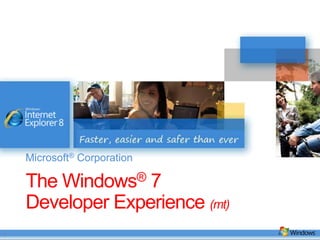Win7 Multi Touch
- 1. The WindowsÂŪ 7 Developer Experience (mt)MicrosoftÂŪ Corporation
- 2. Windows 7 Multi-Touch the future is Here!
- 3. The past drives the future.
- 4. Input DevicesHow many people here use a mouse?When was it invented?1963 !!! by Douglas EnglebartWhen was it first (widely) used?Mid 90âsWhile Xerox put out a computer with a mouse in 1982 and others slowly followed, it was not until the MID 90âs that mice were widely used on the computer (30 YEARS!!!)
- 5. Input DevicesHow many people here use a touch screen?When was it invented?1972 !!! The PLATO IV (Research Scientists At University of Illinois)
- 6. Multi-touch through the years1985: Sensor Frame  (Carnegie Mellon University)1992: Flip Keyboard1995/97: Active Desk
- 7. Multi-touch through the years1999: Portfolio Wall2005: PlayAnywhere2007: Microsoft Surface Computing
- 8. Gestures1983: Video Place / Video Desk (Myron Krueger) Essentially âwrote the bookâ in terms of unencumbered (i.e., no gloves, mice, styli, etc.) rich gestural interaction.
- 9. Touch HistoryAbout the same time themac came out
- 10. Touch Phones2006: Synaptics & Pilotfish (San Jose) http://www.synaptics.com2007: Apple iPhone1992:Â Simon (IBM & Bell South) The first touch phone
- 11. âSo how can I play with this now??â
- 12. 3 things to knowâĶ.the screensthe hardwarethe software
- 13. The Screens
- 14. How to touch ResistiveThink Push Down and drag
- 15. How to touch CapacitiveThink Electric Impulse
- 16. How to touch InfraredThink laser pointer(s)
- 17. The Hardware
- 18. HardwareCapacitiveHP Touchsmart tx2N-trig (2-10)CapacitiveDell LatitudeXT2N-Trig (2-10)InfraredHP Touchsmart IQ816NewWindow(2)
- 19. The Software
- 20. Multi-Touch Development TiersGood â Better â BestWindows application can target one of three levels of touch integrationGood: No specific touch APIs are used but the application UI is appropriately sized and works well with the built-in gesturesBetter: The gesture APIs are supported to give smooth natural interactionsBest: Deep touch-focused experiences designed to take advantage of multi-touch features
- 22. Windows7.MultitouchEasyto Write code nowPCâs, Form Factors, TechnologyWindows7.Multitouch.WPFWM_Touch
- 23. Massive Multi-touch, Multi-userEasier to Write code soonPCâs, Form Factors, Technology
- 24. The API protected event EventHandler<WMTouchEventArgs> Touchdown; // touch down event handlerprotected event EventHandler<WMTouchEventArgs> Touchup; // touch up event handlerprotected event EventHandler<WMTouchEventArgs> TouchMove; // touch move event handler // Private data members private int x; // touch x client coordinate in pixels private int y; // touch y client coordinate in pixels private int id; // contact ID private int mask; // mask which fields in the structure are valid private int flags; // flags private int time; // touch event time private intcontactX; // x size of the contact area in pixels private intcontactY; // y size of the contact area in pixels
- 26. More InformationMulti-Touch Systems that I Have Known and Lovedhttp://www.billbuxton.com/multitouchOverview.htmlMike Taultyâs Blog http://bit.ly/NKVTNExample Photo App http://bit.ly/d4eE9
- 27. Multi-touch is not new1972: PLATO IV Touch Screen Terminal Windows 7 Multi-touchTouchable HologramPresentFuture(http://bit.ly/akq7V)Past
- 28. The End(or a new beginning)
- 31. Leonardo Da VinciHelecopterEight Barrel Machine GunParachute
- 33. George Jetson
- 34. Jet packs
- 39. Guestures and MovementWhat can I do?
- 40. Predefined Gestures â TranslatePlace two fingers in the application window and drag in the direction you want
- 41. Zoom and RotateRotateTouch the image with two fingers and turn fingers in a circleZoomTouch the image with two fingers and move them closer or further apart
- 42. Two Finger Tapand Finger RollTwo Finger TapTap once with both fingersFinger RollPlace one finger on the screen, place second finger on the screen, lift the second finger, and then lift the first finger
- 43. ManipulationsManipulations are a great foundation for touch-optimized experiences. They are:2D affine transformations (translate, scale, rotate)Superset of supported gesturesSupports multiple concurrent manipulationsNeed a source of raw data: WM_TOUCHSimilar to Surface APIsInterfaces:IManipulationProcessorIManipulationEvents
- 44. InertiaProvides basic physicsWorks hand in hand with manipulationsInterfaces:IInertiaProcessorIManipulationEvents â Same event interface as manipulations
Editor's Notes
- #3: Today I am going to talk about something that I think is a Hidden gem. In Windows7 and is going to make a huge impact in the coming year.
- #4: I am a firm believer in UNDERSTANDING the pastâĶ. And using that understanding to guide the future
- #13: I am a firm believer in UNDERSTANDING the pastâĶ. And using that understanding to guide the future





























